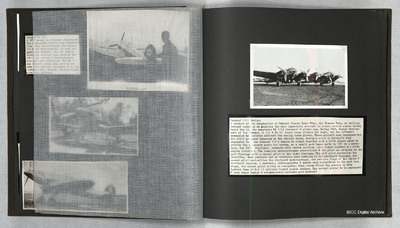Heinkel He 111Z
Title
Heinkel He 111Z
Description
Two He 111 mated together for transport and glider towing.
The view is from the front/ starboard side.
The view is from the front/ starboard side.
Coverage
Language
Type
Format
One b/w photograph on an album page
Publisher
Rights
This content is available under a CC BY-NC 4.0 International license (Creative Commons Attribution-NonCommercial 4.0). It has been published ‘as is’ and may contain inaccuracies or culturally inappropriate references that do not necessarily reflect the official policy or position of the University of Lincoln or the International Bomber Command Centre. For more information, visit https://creativecommons.org/licenses/by-nc/4.0/ and https://ibccdigitalarchive.lincoln.ac.uk/omeka/legal.
Identifier
PThomasAF20070016
Transcription
[Photograph]
Heinkel 111Z Series.
A product of the imagination of General Oberst Ernst Udet, the Siamese Twin, or Zwilling concept resulted in possibly the most improbable aircraft to attain service status during World War II, the monstrous HE 111Z transport & glider tug. During 1940, design development of the immense Ju 322 & Me 321 heavy cargo gliders had begun, but the Luftwaffe possessed no suitable aircraft for towing these giants. These aircraft were developed for the still proposed invasion of the British Isles. During a visit to Heinkel’s Udet suggested that two Heinkel 111’s should be linked together with a fifth engine added to provide the necessary power for towing, as a result work began early in 1941 on a prototype. Two HE111 fuselages complete with centre sections were linked together & a fifth engine installed. Two complete undercarriages were retained & the pilot was situated in the port fuselage with a second pilot in the right fuselage. The port pilot controlled the throttles, dual controls but no throttles were installed in the starboard fuselage, the second pilot controlline [sic] the starboard undercarriage, the radiator flaps of the centre & starboard engines. A mechanic, radio-operator & gunner were accommodated in the port fuselage, the second pilot acting as navigator. Type- Heavy Glider Tug powered by five Junkers Juno 211F-2 12 cylinder liquid cooled engines. The concept proved to be successful & long range bomber & reconnaisance [sic] variants were proposed
Heinkel 111Z Series.
A product of the imagination of General Oberst Ernst Udet, the Siamese Twin, or Zwilling concept resulted in possibly the most improbable aircraft to attain service status during World War II, the monstrous HE 111Z transport & glider tug. During 1940, design development of the immense Ju 322 & Me 321 heavy cargo gliders had begun, but the Luftwaffe possessed no suitable aircraft for towing these giants. These aircraft were developed for the still proposed invasion of the British Isles. During a visit to Heinkel’s Udet suggested that two Heinkel 111’s should be linked together with a fifth engine added to provide the necessary power for towing, as a result work began early in 1941 on a prototype. Two HE111 fuselages complete with centre sections were linked together & a fifth engine installed. Two complete undercarriages were retained & the pilot was situated in the port fuselage with a second pilot in the right fuselage. The port pilot controlled the throttles, dual controls but no throttles were installed in the starboard fuselage, the second pilot controlline [sic] the starboard undercarriage, the radiator flaps of the centre & starboard engines. A mechanic, radio-operator & gunner were accommodated in the port fuselage, the second pilot acting as navigator. Type- Heavy Glider Tug powered by five Junkers Juno 211F-2 12 cylinder liquid cooled engines. The concept proved to be successful & long range bomber & reconnaisance [sic] variants were proposed
Collection
Citation
“Heinkel He 111Z,” IBCC Digital Archive, accessed November 4, 2024, https://ibccdigitalarchive.lincoln.ac.uk/omeka/collections/document/23215.
Item Relations
This item has no relations.

